If you want your business to incorporate cloud computing, AI enablement, or process automation, then you need a strong, scalable it infrastructure.
What is it infrastructure for a company?
Is it about hardware and data centers? Software platforms and operating systems? Or network connectivity and security?
It’s all of that and more.
IT infrastructure is the foundation that supports your digital transformation, enabling agility, resilience, and operational excellence.
Without it, your initiatives risk underperformance, inefficiency, and wasted investment.
What is IT Infrastructure for A Company?
For today’s Saudi organizations, IT infrastructure is the strategic foundation that fuels business agility, innovation, and compliance.
It’s far more than just the sum of hardware, software, and networks.
Modern IT infrastructure is an integrated environment, combining on-premises, cloud, and hybrid resources, that enables secure, seamless connectivity, supports mission-critical applications, and ensures rapid, reliable access to data throughout the enterprise.
It reframes infrastructure as a strategic and competitive asset, not just technical plumbing. It also references local/regional context: hybrid/remote work, digital transformation, PDPL/NCA, and Vision 2030.
What are IT Infrastructure Services
IT infrastructure services are the critical enablers behind every business outcomem, from seamless collaboration and secure customer engagement, to high-performance analytics and compliance with national regulations like PDPL and NCA.
1. Cloud Computing
Proper network components in an IT infrastructure, which provide a fast and secure internet connection, are essential for efficient cloud computing services. This use case is essential for the modern business world.
2. Disaster Recovery
Restoring your business data in the event of data loss due to a cyberattack, natural disaster, or failure of a critical infrastructure component. This protects crucial data, minimizes downtime, and increases the availability of your critical systems.
3. Big Data Analytics
Data is everywhere, and data volume is increasing exponentially. Having big data analytics in your toolset means exploiting this resource to gain actionable insights that boost business performance. This feature can be enhanced by employing AI or ML for automation and a shorter time to insight.
4. DevOps
Software development businesses rely heavily on IT infrastructures, particularly cloud-enabled models, to facilitate real-time collaboration within their DevOps teams. By automating processes and optimizing cooperation, they can reduce software development cycles.
5. Operations
Many businesses focus on removing operational redundancy and reallocating time from low-value manual tasks to high-value work when leveraging AI and ML. These applications include streamlining outdated processes, automating workflows, and accelerating the analysis of high-volume data.
How Do the Components of IT Infrastructure Work?
Enterprise infrastructure isn’t just a technical stack, but it’s a strategic system. When built right, the interplay between hardware, software, and networks forms a foundation for continuous performance, resilience, and innovation.
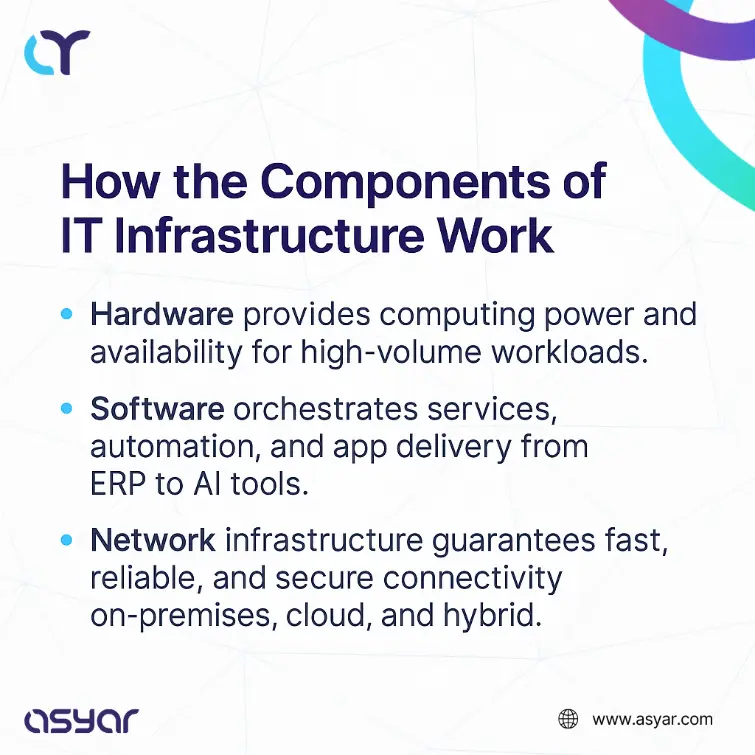
At scale, these components must work interdependently:
- Infrastructure must support containerized apps, zero-trust architectures, and compliance by design.
- Workloads must move seamlessly across environments based on performance, risk, or cost.
- Infrastructure operations (InfraOps/IaC) and observability must be embedded from the start.
This is the backbone behind cloud agility, real-time data architecture, and Vision 2030, a level transformation in leading Saudi organizations.
The 7 Components of IT Infrastructure: Key Pillars of Modern Digital Transformation
For business leaders exploring what is IT infrastructure for a company, understanding the modern strategic considerations of the seven foundational components is essential to build a resilient and future-ready IT infrastructure.
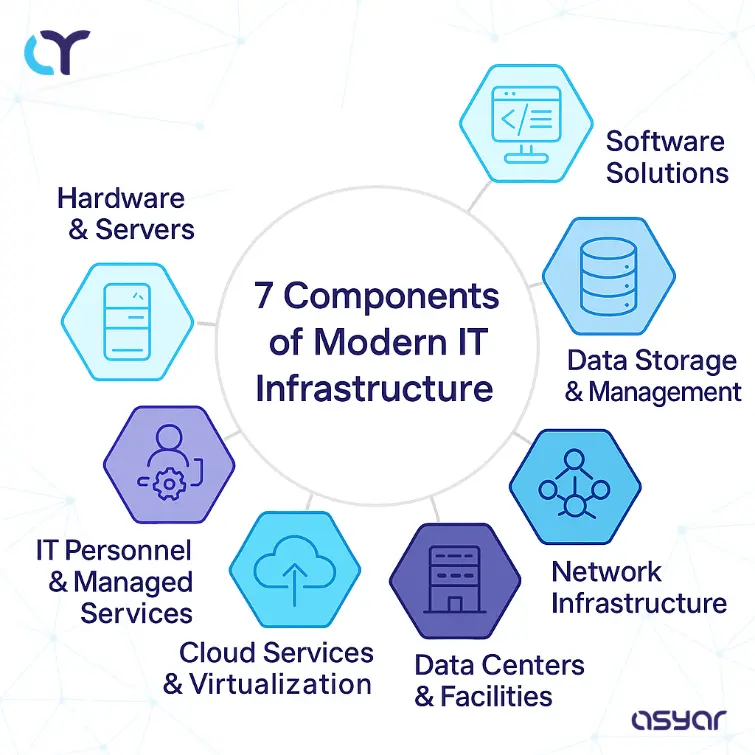
Contact the IT Infrastructure expert at Asyar Company
1. Hardware & Servers
- Ever-growing data volumes increase the need for rapid scaling and resource pooling. By opting for modular, composable infrastructure, you can enhance your infrastructure’s resource pooling.
- Prioritize edge computing capabilities to reduce latency and support distributed applications.
- Balance cost and performance through predictive capacity planning and infrastructure lifecycle management.
2. Software Solutions
- Deploy intelligent, API-driven software stacks that enable seamless integration across hybrid environments and accelerate automation.
- Utilize platforms that embed security-by-design and support compliance frameworks, reducing risk and operational overhead.
- Embrace containerization and microservices architectures to enhance agility and innovation velocity.
3. Data Storage & Management
- Structure storage to allow secure, on-demand data retrieval, enabling faster decision-making across teams.
- Leverage tiered storage and hybrid cloud models to balance cost and performance, accelerating AI/ML analytics and real-time insights.
- Integrate unstructured and structured data management to unlock new business opportunities and intelligence.
4. Network Infrastructure
- Design software-defined, intent-based networks offering autonomous optimization and real-time threat mitigation.
- Integrate 5G and SD-WAN technologies to support dispersed workforce models and IoT expansion aligned with national priorities.
- Focus on zero-trust network frameworks to mitigate sophisticated cyber risks and ensure regulatory compliance.
5. Data Centers & Facilities
- Adopt hyper-converged infrastructure principles for improved agility, operational efficiency, and seamless hybrid cloud extensions.
- Implement advanced energy management systems aligned with Saudi sustainability mandates to reduce carbon footprint.
- Design for scalability and redundancy to ensure zero downtime in mission-critical environments.
6. Cloud Services & Virtualization
- Leverage cloud-native architectures embracing multi-cloud portability, enhancing service resiliency and governance.
- Utilize advanced virtualization and orchestration frameworks for automated workload balancing and disaster resilience.
- Align cloud strategies with NCA guidelines, embedding continuous compliance and risk assessment.
7. IT Personnel & Managed Services
- Cultivate next-gen IT leadership through continuous upskilling focused on cloud, security, and AI-driven orchestration.
- Partner strategically with MSPs to augment capabilities, reduce time-to-market, and maintain operational continuity.
- Emphasize cross-disciplinary collaboration to break silos and drive holistic infrastructure innovation.
Beyond Hardware and Software: Key Components of a Complete IT Infrastructure
While hardware and software form the foundation of any IT environment, a truly modern and resilient infrastructure goes far beyond these basics.
Integrating critical components ensures high performance, guarantees security, and enables scalability.
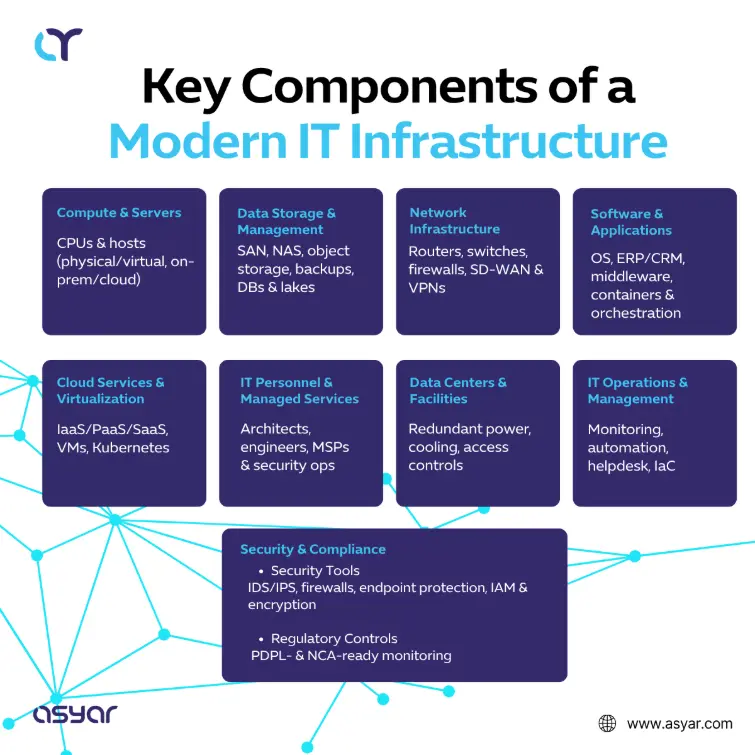
What is Part of a Modern IT Infrastructure?
Understanding what is IT infrastructure for a company, and especially a modern infrastructure, can help businesses achieve their strategic goals.
At Asyar, we rely on state-of-the-art components provided by the best partners in the industry to build your IT Infrastructure.
The key components we provide include:
Hardware and Servers
We rely on trusted brands like Lenovo, Dell, HP, Apple, ASUS, and Canon to provide reliable computing power and device performance.
Software Platforms
With solutions from Microsoft, Adobe, and AutoCAD, we empower productivity, collaboration, and digital content creation.
Networking Solutions
Asyar builds robust networks utilizing technologies from Aruba and SonicWall, ensuring secure and high-performance connectivity.
Data Storage Systems
We offer fast and secure data access through SanDisk, Lexar, Kingston, and PNY storage technologies.
Cloud Services & Virtualization
Through partners like VMware and Teradata, we deliver scalable cloud solutions and virtual environments.
Cybersecurity Tools
Our clients benefit from enterprise-level protection using McAfee, Symantec, and Norton.
IT Personnel & System Management
Our certified professionals use tools like ManageEngine and Veeam to monitor, maintain, and optimize IT environments.
By integrating these components, Asyar ensures not only that your IT foundation is secure, agile, and future-ready but also fully aligned with Saudi Arabia’s Vision 2030.
What are the 3 Types of IT Infrastructure?
Your business IT infrastructure can be centralized within a data center, whether it’s on-premise or on-cloud. It can also be decentralized and distributed across multiple data centers through a cloud provider.
This flexibility gives way to three main types of IT Infrastructure.

1. Traditional Infrastructure
The most popular option until the early 2000s, this infrastructure depends on physical hardware components such as servers, routers, and cables.
All the components are kept on-premises, and are privately used by the company, whether in the main office building or at a data center.
Advantages
- Adapts well with legacy systems and specialized industries
- Affords total control over infrastructure and meets strict security regulations
Disadvantages
- High initial investment on physical components
- Requires hiring a dedicated IT team
- Difficulty in scalability
2. Cloud Infrastructure
The rise of cloud services companies made this the trend in recent years. Cloud infrastructure provides your business with computing needs over the internet by relying on the physical components of third parties through services such as Iaas (Infrastructure as a Service).
Advantages
- Lower initial costs (depends on recurring payment to service provider)
- High scalability and flexibility in updating components
- Easier adoption of technologies such as virtualization, AI, gen AI, machine learning (ML), and Internet of Things (Iot)
Disadvantages
- Operational costs can be higher than traditional systems
- Less control over the IT infrastructure (owned by third party)
- High dependency on a strong and stable internet connection
3. Hyperconverged Infrastructure (HCI)
Following the early 2000s, a growing competition emerged between traditional and cloud infrastructure, leading to the development of a hybrid model in 2011.
Recent reports show that its market value is forecasted to reach USD 558.6 billion by 2032, up from USD 125 billion in 2023.1
The HCI model combines both traditional and cloud infrastructure to provide flexibility and optimize costs. They can be categorized into three types:
1. On-Premises
Resources are stored on-site at the company’s office building or data center.
2. Public Cloud
Resources are hosted on a public cloud owned by a third-party cloud service provider that provides computing services to multiple companies.
3. Private Cloud
Resources are hosted through a virtualized infrastructure, which is only available to one single customer.
Types and Emerging Models of IT Infrastructure
As Saudi Arabia pursues its Vision 2030 digital transformation, understanding the importance of IT infrastructure is increasingly vital for businesses.
IT infrastructure has become much more than simply a support function; it's essential to an organization's ability to adopt new technologies, increase efficiency, and remain competitive.
Generally, IT infrastructure models can be grouped into three main functional categories:
1. Infrastructure Types by Deployment Model
On-premises
Traditional IT infrastructure is hosted within a company’s own facilities.
Cloud Computing
Delivery of IT resources over the internet, which aligns with the Saudi Arabian government’s cloud-first policies.
Hybrid IT Infrastructure
A strategic blend of on-premises and cloud resources that Saudi enterprises widely adopt to meet diverse operational needs.
2. Modern & Advanced Infrastructure Concepts
Composable Infrastructure
This modular IT architecture enhances agility and efficiency by dynamically allocating resources.
Computing resources are disaggregated and treated as pools of services, enabling the flexible allocation of resources according to the specific function or workflow required by the system.
Dynamic Infrastructure
A model of cloud computing that is capable of dynamically adjusting resource use according to changing demands. Through this real-time scalability, computing power, storage, and networking usage can be optimized efficiently.
Immutable Infrastructure
Instead of modifying infrastructure components during a system update, the deployed components are replaced with new and pre-configured versions. This approach simplifies deployment of updates and eliminates the potential for configuration drift and manual errors, ensuring a reliable and consistent environment.
3. Supporting & Specialized Infrastructures
Internet Infrastructure
The foundational network for internet connectivity and communication. It is crucial to ensure high availability, reliability, and security of this infrastructure.
Contact Center Infrastructure
Specialized setups with the specific purpose of communication with customers for various customer service functions. They also serve to integrate communication channels for more reliable data collection and enhanced data analysis to improve client engagement.
Critical Infrastructure
These are the IT systems responsible for national security and provision of vital services. While all IT infrastructures must comply with Saudi cybersecurity regulations, these systems have more stringent protection and are under more strict scrutiny.
Dark Infrastructure
Hidden IT assets that provide support functions for business operational continuity and security. They include backup systems, disaster recovery, and failover mechanisms.
The Limitations of Traditional IT Infrastructure
While traditional IT infrastructure may offer more control and a higher sense of security than cloud infrastructures, the fact is that there are many reasons why the majority of businesses in Saudi Arabia and around the world are opting for hybrid or cloud models.
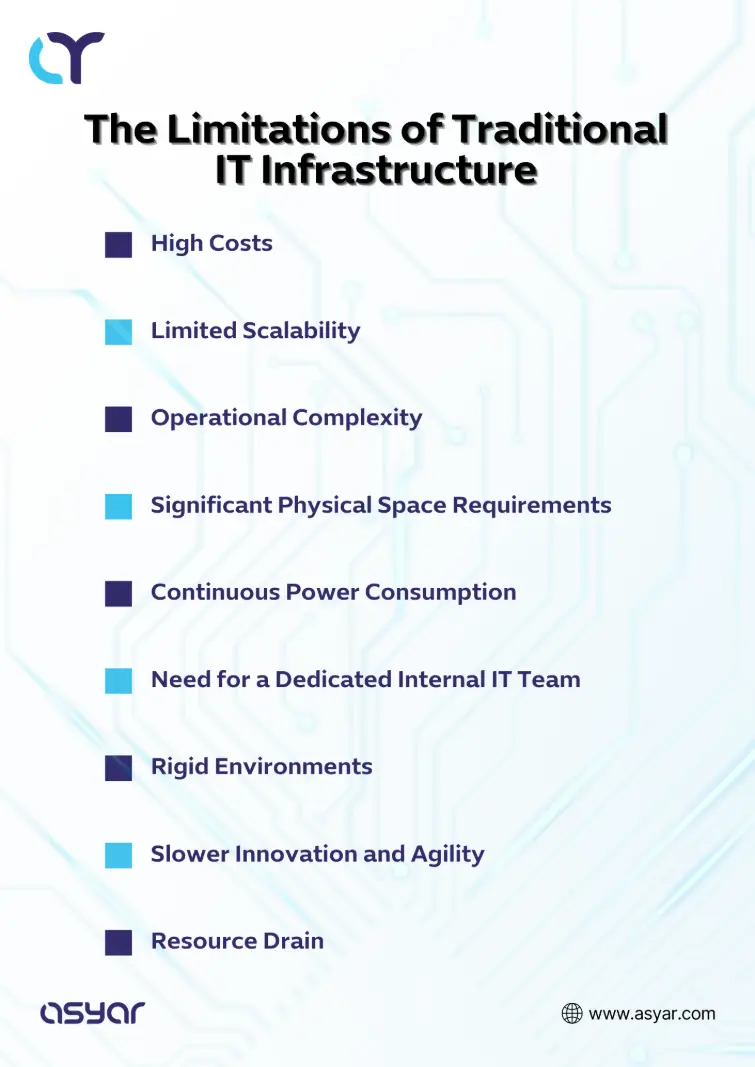
High Costs
- Upfront investment to purchase servers, storage, network devices, and even software licenses.
- Ongoing expenses on maintenance, upgrades, and operational costs.
Limited Scalability
- Rigid expansion as scalability requires new purchases and lengthy deployment.
- Underutilization when processing needs go down; computing resources are wasted.
Operational Complexity
- Integration challenges in managing diverse hardware and software components, especially with upgrades.
- Manual processes for updates and troubleshooting slows down IT performance.
Significant Physical Space Requirements
- On-premises footprint of physical servers and storage arrays take up a lot of space.
- Real estate costs are a burden on the business especially with growing infrastructure needs.
Continuous Power Consumption
- Energy demands are continuous to keep servers, cooling systems, and backup features up and running.
- Environmental impact is huge due to high energy consumption and a large carbon footprint.
Need for a Dedicated Internal IT Team
- Specialized skills needed make hiring a challenge, and management of employees an ongoing process.
- Resource allocation is unbalanced as IT teams are engrossed in maintenance and troubleshooting not strategic projects.
Rigid Environments
- Lack of flexibility in updating systems or integrating new technologies.
- Data silos may form due to lack of integration between legacy systems and modern components.
Slower Innovation and Agility
- Delayed deployments make it difficult to launch new services or features due to the complexity of upgrades.
- Resistance to change is more prominent intrinsically due to system rigidity and from managers due to high costs and extended deployments.
Resource Drain
- Ongoing maintenance burden as time and money is continuously spent just to keep the system running.
- Downtime risks are higher due to aging hardware which makes it more prone to failure.
Stop holding yourself back by infrastructure that drains your resources. Empower your organization with Asyar’s intelligent IT solutions, built for Saudi Arabia’s Vision 2030 and beyond.
Characteristics of An Optimal IT Infrastructure in Saudi Arabia.
You must not only ask yourself what is IT infrastructure for a company, but what makes it optimal or ideal for your specific business?
Scalability, flexibility, and reliability are among the most critical metrics to consider when building an IT infrastructure. In the demanding Saudi market, businesses require an optimal IT infrastructure to stay competitive. What characteristics are essential for this?
High-Performance Storage
A high-performance storage system reduces bottlenecks, accelerates data access, and enables scalability in a growing business with increasing data volumes.
Low-Latency Networks
Fast connectivity is essential for real-time collaboration between teams and for faster data and file sharing. This becomes especially important for businesses with international customers. Saudi Arabia has an expanding fiber-optic and 5G network, which means that Saudi businesses can benefit from state-of-the-art network devices.
Secure Infrastructures
Compliance with Saudi regulations is mandatory for local businesses. An optimal IT infrastructure ensures compliance and secures business data through the use of firewalls, encryption, identity management, and other security measures.
Wide Area Networks (WANs)
When businesses expand internationally, WANs help maintain efficient communication lines between dispersed offices and data centers. This goes back to reducing latency and improving processing speed and performance.
Virtualization
Running multiple VMs on a single physical server improves performance at an optimized cost. Businesses gain more flexibility and have faster deployment of new applications and services.
Zero Downtime
Downtime incurs a high opportunity cost due to disrupted operations, a damaged reputation resulting from a lack of reliability, and additional costs to get the system back up and running. A robust IT infrastructure would feature redundant systems, failover mechanisms, and proactive monitoring to mitigate these costs.
What Does an Optimal IT Infrastructure Look Like?
Operating System Management
Monitors environments running on the same operating system and provides content, patches, deployment, and subscription management.
Cloud Management
Enables cloud administrators to control all components running in a cloud, such as data, applications, services, and end users. This includes provisioning, consuming, integrating resources, and managing disaster recovery. Disaster recovery.
Virtualization Management
Serves as an interface between virtual environments and the underlying physical hardware. It simplifies resource management, improves data analysis, and streamlines operations.
IT Operations Management
Also referred to as business process management, it models, analyzes, and optimizes ongoing or predictable business processes.
IT Automation
By creating repeatable instructions and processes, human interactions with IT systems are replaced or reduced, a concept also referred to as infrastructure automation.
Container Orchestration
Automates containers’ deployment management, scaling, and networking.
Configuration Management
Consistently manages computer systems, servers, and software.
API Management
Distributes, controls, and analyzes APIs that connect applications and data between enterprises and clouds.
Risk Management
Identifies and assesses risks and develops plans to minimize or control them and their potential impact.
Data Management
Captures, stores, and uses data. Organizations gain visibility into what data exists, where it is located, who owns it, who has access to it, and how it is accessed.
Additional Benefits of a Strong IT Infrastructure
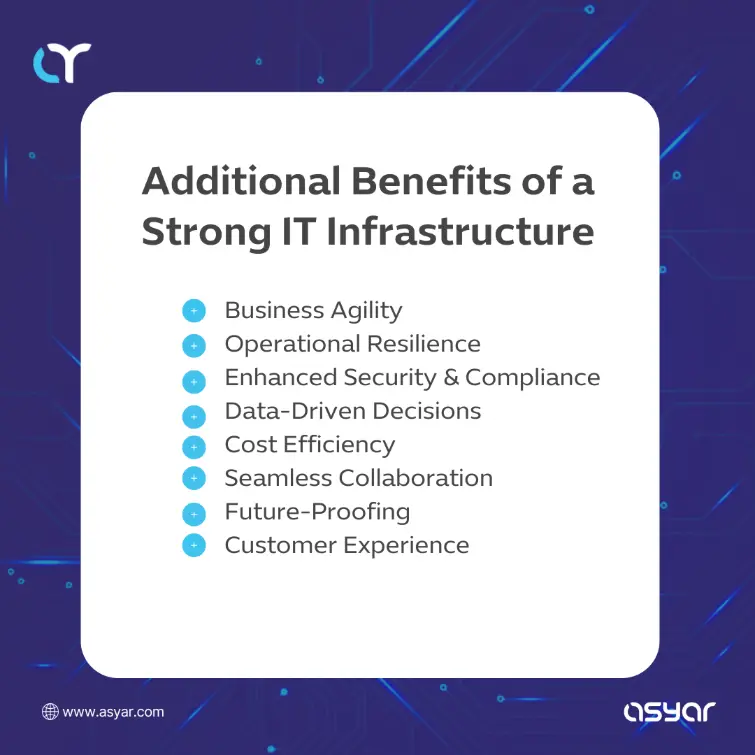
Keep your data safe: Secure storage and easy access go hand-in-hand.
- Teamwork makes the dream work: Connect everyone and everything seamlessly.
- Work smarter, not harder: Get the most out of your resources.
- Fort Knox for your data: Keep it protected from prying eyes.
- The tools you need to succeed: Streamline your processes with powerful applications.
If you want to learn more about what is IT infrastructure for a company and how you can build a strong one for your organization, contact us today to learn more about your options.
Why is IT Infrastructure Important?
The changing markets and the growing data needs make IT infrastructure even more important. In Saudi Arabia, the ICT market alone is valued at over USD 12 billion, and is expected to reach USD 22.84 billion by 2030.2
The Kingdom is also expanding into larger markets and gaining more exposure than ever, so Saudi businesses like yours must be prepared for it.
Enables Business Operations
All core business functions rely on IT infrastructure, including communication, data processing, service delivery, and customer engagement.
Enhances Efficiency and Productivity
Streamlining time-consuming workflows and automating manual tasks enables a more efficient allocation of time, shifting it towards high-value activities and accelerating decision-making.
Ensures Data Security and Compliance
A robust system enhances protection and ensures compliance with Saudi Arabia’s stringent data security requirements, as outlined in the Personal Data Protection Law (PDPL) and established by organizations such as the Saudi Data and Artificial Intelligence Authority (SDAIA) and the National Cybersecurity Authority (NCA).
The Kingdom is a global leader in cybersecurity, and its cybersecurity market is expected to reach USD 9.8 billion by 2026.3
Improves Customer Experience
A reliable system means your customers have 24/7 access to your business. It ensures excellent communication, faster delivery, personalized engagement, and even comprehensive data collection and analysis.
Reduces Downtime and Business Risks
To maintain a strong market reputation, your business has to be highly available. Downtime not only hurts your profits directly, but also makes customers second-guess their trust for your business.
Optimizes Cost Management
By choosing the ideal model and components for your IT infrastructure such as leveraging cloud and hybrid models, you can optimize initial and recurring costs to maximize ROI.
Drives Innovation and Cloud Transformation
A modern IT infrastructure supports the adoption of cloud services, AI, and IoT, empowering businesses to innovate rapidly and adapt to market changes.
In Saudi Arabia, market sizes for these innovations are expected to grow rapidly, with cloud services expected to make up to 30% of total Saudi ICT expenditure by 2030.4
Empowers Agility and Competitive Advantage
Flexible and scalable IT environments enable Saudi companies to respond quickly to evolving customer demands and industry trends.
The Saudi market is growing at rapid rates, with the Kingdom ranked first globally in the 2025 ICT Development Index issued by the International Telecommunication Union (ITU).5
How to Ensure Security in IT Infrastructure
Saudi Arabia’s leading position in cybersecurity and rapidly growing digital market make it a top target for cybersecurity attacks. Similar to technologies, cyberattacks also evolve, so Saudi businesses must always stay up-to-date with the latest threats.
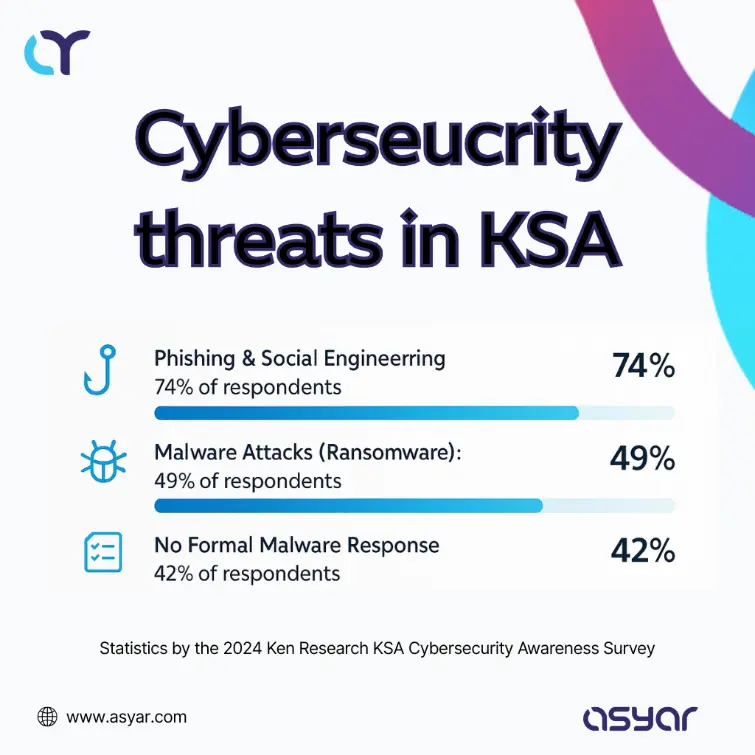
Malware Attacks
Many cybercriminals are using ransomware-as-a-service (RaaS) platforms to target businesses and demand hefty ransoms especially in the energy, healthcare, and transportation sectors.
How to Combat them?
- Deploy advanced endpoint detection and response (EDR) solutions with behavioral analytics.
- Implement continuous patch management to close vulnerabilities promptly.
- Use network segmentation to contain malware spread and minimize impact.
Phishing and Social Engineering
The most common cybersecurity threat in the Kingdom, Gen AI is giving a major boost to these attacks by helping craft convincing fraudulent emails or even using deepfake voice fraud for a more convincing attack.
How to Combat them?
- Enforce multi-factor authentication (MFA) across all access points.
- Conduct regular, scenario-based employee training and phishing simulations.
- Integrate email filtering with AI-driven threat detection to block malicious content.
Denial-of-Service (DoS) Attacks
Saudi Arabia is one of the most targeted countries in the MENA region when it comes to DoS attacks, and especially Distributed Denial-of-Service (DDoS) attacks.
In 2024, the Kingdom faced record-breaking multi-vector DDoS attacks reaching peak bandwidths of 2 Tbps, severely impacting government and energy sectors.
How to Combat them?
- Utilize scalable, cloud-based traffic filtering and DDoS mitigation services.
- Implement network redundancy and failover mechanisms to maintain service continuity.
- Monitor traffic patterns with real-time analytics to identify and neutralize attacks early.
Data Breaches
While cloud systems offer more flexibility and scalability, they can be less resilient against these types of attacks.
Cybercriminals exploit vulnerabilities in cloud systems, remote access, and third-party supply chains, exposing organizations to financial loss and reputational damage.
How to Combat them?
- Apply strong encryption for data at rest and in transit aligned with NCA cryptographic standards.
- Enforce strict access controls and continuous monitoring with automated anomaly detection.
- Develop and regularly update incident response and breach notification protocols complying with PDPL.
Insider Threats
Proper monitoring and training are essential to protect a business from insider threats, whether malicious or accidental. Employees and new hires must understand what IT infrastructure is for a company and how it affects their work habits.
How to Combat them?
- Eliminating system misconfigurations
- Implementing robust access controls
- Creating formal incident response plans.
- Ensure continuous employee training to prevent misuse of data and accidental insider threats.
How Infrastructures are Created
No matter the size, understanding what is IT infrastructure for a company is essential for building secure and effective technology environments.
This is achieved through a strategic process that follows a specific step-by-step procedure to ensure optimization, cost savings, and a sustainable and scalable system.
1. Needs Assessment
Ensure alignment between IT capabilities and evolving business objectives.
It’s essential to take Vision 2030 mandates and compliance requirements in consideration at this stage to future-proof your organization’s IT investments.
2. Planning & Design
Consider a flexible architecture that can incorporate emerging models and trends in the IT infrastructure landscape.
Prioritize scalability, security-by-design, and interoperability—enabling agile adaptation to emerging technologies and business models.
3. Hardware Procurement
Source high-performance, energy-efficient hardware to minimize your organization’s carbon-footprint and save on energy costs.
Opt for hardware with modular scalability to support edge computing and latency-sensitive applications, optimizing TCO (Total Cost of Ownership) and lifecycle impact.
4. Software Installation
Implement cloud-native, API-first software ecosystems to enable automation and real-time analytics.
Such systems also facilitate seamless integration with legacy systems to give you maximal operational agility.
5. Network Configuration
Design software-defined, zero-trust networks with built-in redundancy and advanced threat detection, ensuring resilient connectivity and regulatory compliance.
6. Security Setup
Align with PDPL and NCA standars through layered security posture by combining encryption, identity governance, and continuous monitoring.
7. Testing & Optimization
Streamline your testing operations with AI and use simulation tools to validate performance, security, and disaster recovery.
8. Monitoring & Maintenance
Deploy AI-driven observability platforms for real-time health insights, proactive anomaly detection, and predictive maintenance.
How to Create an IT Infrastructure from Scratch
Building IT infrastructure from scratch is a complex yet critical endeavor that requires careful strategic planning to align with business objectives. The right components must be selected to meet current needs and anticipate future demands.
For Saudi organizations embarking on this journey, Asyar provides a detailed, step-by-step guide that addresses these challenges and offers practical best practices. You can check out this roadmap here and start your journey towards digital transformation.
What Factors Should I Consider when Choosing an IT Infrastructure Model?
- Business Needs & Goals
Anticipate with your organization’s future size, market, demands, and goals to keep your IT infrastructure future-proof and adaptable.
- Scalability
Opt for architectures supporting elastic growth to ensure resources match workload volatility with minimal manual intervention.
- Cost & Budget
Consider potential long-term costs not just upfront affordability. More expensive systems can end up being more economical on the long-run with features such as automation, predictive analytics, and rightsizing.
- Security Requirements
Prioritize security architectures that embed zero-trust principles, continual risk assessments, and adaptive threat response in real time.
- Compliance & Regulations
Compliance with Saudi regulations is essential, so select systems that support rapid policy updates to stay up-to-date and resilient towards advanced cyber threats.
- Performance & Reliability
Search for features such as predictive maintenance, AI-driven optimization, and realtime monitoring for high performance.
Consider solutions with architectural redundancy, auto-heal capabilities, and transparent SLA guarantees to maximize your system’s operability.
- Flexibility & Customization
Favor modular platforms supporting low-code integrations and open APIs, enabling tailored workflows, new business models, and fast adoption of emerging technologies.
- IT Team Capabilities
Prioritize user-friendly systems and invest in team training to close down any potential skill gaps.
- Integration with Existing Systems
Reduce integration friction through standardized connectors and orchestrated data governance across hybrid environments.
- Disaster Recovery & Backup
Evaluate real-time recovery capabilities, testing frameworks, and compliance with national continuity regulations.
How to Choose the Right IT Infrastructure for Your Business
Take a pragmatic approach when selecting the IT infrastructure for your business.
- Assess your current business needs and future growth plans.
- Evaluate key factors offered by the model (Scalability, Security, Compliance, Performance, Integration).
- Align with Saudi Arabia laws and regulations.
- Choose the right deployment option for your budget and needs (on-premises, cloud, or hybrid).
- Partner with experts like Asyar who offer tailored solutions and possess local market expertise.
Ready to build a future-proof IT infrastructure?
Contact Asyar today for expert advice and customized solutions that drive your digital transformation in Saudi Arabia.
Best Practices for IT Infrastructure Management
Saudi organizations are expected to provide reliable services to their customers, which creates a need for a robust IT infrastructure.
Implementing best practices, such as regular audits and continuous performance monitoring, helps minimize risks and downtime.
1. Start with a clear infrastructure architecture
Define a well-structured and scalable design aligned with your business goals. Leaders should clarify what is IT infrastructure for a company to managers and employees so each one knows their role in IT infrastructure management.
2. Centralize service management
Use centralized platforms like Network Operations Centers (NOC) to streamline monitoring, incident response, and operational control.
3. Embrace virtualization
Helps you maintain your infrastructure for longer by maximizing hardware utilization and reducing physical footprint.
4. Monitor system resources and hardware continuously
Opt for real-time monitoring to track and optimize performance, and detect anomalies early to minimize downtime.
5. Prioritize infrastructure security
Manage cyber threats properly by complying with Saudi regulations and adopting multi-layered security measures (firewalls, encryption, regular audits, and employee training).
6. Document infrastructure requirements and changes
A huge part of management is looking ahead to the future. A detailed documentation of policies, configurations, and updates maintains transparency and clarity for future troubleshooting or updates.
How Can I Ensure the Ongoing Maintenance and Support of My IT Infrastructure?
Implementing best practices in IT infrastructure maintenance helps you keep a high-performance system. But ensuring the continuity of these practices is a different approach.
Regular System Monitoring
Tools like Nagios or Solarwinds are very useful for continuous real-time monitoring of:
- System health
- Resource Usage
- Network Performance
- Technical issues (early detection)
Scheduled Maintenance Plans
Stay proactive with preventive maintenance processes such as:
- Hardware inspections, cleaning, and lubrication
- Periodic software updates
- Implementing usage threshold to reduce wear
Automated Alerts & Incident Response
Decrease response time and remediate issues before they escalate by:
- Automatic alerts for anomalies for instant detection.
- Incident response protocols to decrease mean time to respond.
Backup and Disaster Recovery
Helps you ensure business continuity by quickly going back to a restore point to minimize downtime due to disruptions or data loss.
Software Updates and Patch Management
Keeping your system up to date closes down vulnerabilities and maintains compliance with Saudi cybersecurity regulations.
Security Audits and Vulnerability Scanning
Make sure to follow a strict schedule for these operations to identify any new vulnerabilities and mitigate their risks.
Documentation and Asset Management
Keep detailed records of infrastructure configurations, changes, and asset inventories to support troubleshooting, compliance, and knowledge transfer.
IT Support Team or Managed Service Provider (MSP)
You need a skilled team to help you manage these operations. You can do that by:
- Hiring a qualified internal team and managing them properly.
- Training your existing IT team and dedicating a few employees to IT maintenance.
- Partnering with an experienced MSP to gain:
- 24/7 support
- Proactive monitoring
- Expert management
- Tailored services according to local market needs
Performance Optimization and Reporting
Continuously analyze performance metrics and generate reports to:
- Optimize resource allocation.
- Improve efficiency.
- Plan for future capacity.
User Training and Support Channels
Provide ongoing training and accessible support channels to:
- Empower users.
- Reduce human error.
- Enhance security awareness.
This may sound like a lot to do, and it is. Building and maintaining an IT infrastructure is a heavy load on any organization.
This is why Asyar will support you with these essential maintenance and support services should you choose to entrust us with your IT infrastructure.
IT Infrastructure Management Companies
Effective IT infrastructure management is crucial for the continued smooth operations and security of your business.
Once your IT infrastructure is established, the job never ends from preventive maintenance to security upgrades, and realignment with the growing business goals and changing market and business environment.
The digital landscape in Saudi Arabia is ever evolving, which is why you need a trusted partner that understands the local market. Asyar stands out as a leading provider of IT infrastructure management in the Kingdom.
What sets us apart is our tailored, end-to-end solutions and deep expertise in digital transformation, cloud migration, and overall IT infrastructure management services.
Contact us today to discover more about what is IT infrastructure for a company and how it applies to your organization.
References
- https://www.imarcgroup.com/hybrid-cloud-market
- https://www.globenewswire.com/news-release/2025/05/13/3080396/28124/en/Saudi-Arabia-Enterprise-ICT-Market-Analysis-Report-2025-AI-and-Cloud-Technologies-Propel-ICT-Expansion-Competition-Forecast-Opportunities-to-2030.html
- https://www.trade.gov/country-commercial-guides/saudi-arabia-information-and-communications-technology
- https://www.arabnews.com/node/1916646/business-economy
- https://www.cst.gov.sa/en/N2025070301
- https://www.kenresearch.com/industry-reports/ksa-cybersecurity-industry